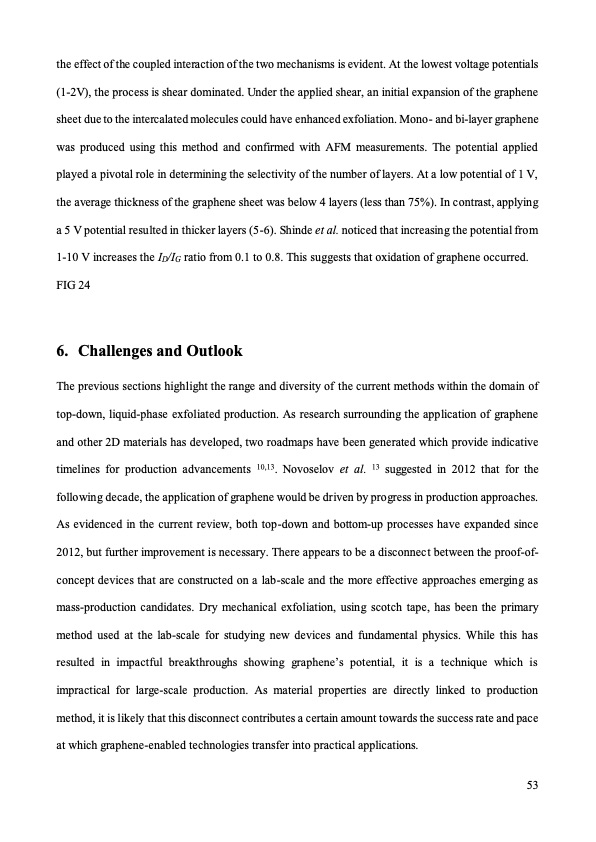
PDF Publication Title:
Text from PDF Page: 053
the effect of the coupled interaction of the two mechanisms is evident. At the lowest voltage potentials (1-2V), the process is shear dominated. Under the applied shear, an initial expansion of the graphene sheet due to the intercalated molecules could have enhanced exfoliation. Mono- and bi-layer graphene was produced using this method and confirmed with AFM measurements. The potential applied played a pivotal role in determining the selectivity of the number of layers. At a low potential of 1 V, the average thickness of the graphene sheet was below 4 layers (less than 75%). In contrast, applying a 5 V potential resulted in thicker layers (5-6). Shinde et al. noticed that increasing the potential from 1-10 V increases the ID/IG ratio from 0.1 to 0.8. This suggests that oxidation of graphene occurred. FIG 24 6. ChallengesandOutlook The previous sections highlight the range and diversity of the current methods within the domain of top-down, liquid-phase exfoliated production. As research surrounding the application of graphene and other 2D materials has developed, two roadmaps have been generated which provide indicative timelines for production advancements 10,13. Novoselov et al. 13 suggested in 2012 that for the following decade, the application of graphene would be driven by progress in production approaches. As evidenced in the current review, both top-down and bottom-up processes have expanded since 2012, but further improvement is necessary. There appears to be a disconnect between the proof-of- concept devices that are constructed on a lab-scale and the more effective approaches emerging as mass-production candidates. Dry mechanical exfoliation, using scotch tape, has been the primary method used at the lab-scale for studying new devices and fundamental physics. While this has resulted in impactful breakthroughs showing graphene’s potential, it is a technique which is impractical for large-scale production. As material properties are directly linked to production method, it is likely that this disconnect contributes a certain amount towards the success rate and pace at which graphene-enabled technologies transfer into practical applications. 53PDF Image | graphene production via nonoxidizing liquid exfoliation

PDF Search Title:
graphene production via nonoxidizing liquid exfoliationOriginal File Name Searched:
Graphene-R2-review.pdfDIY PDF Search: Google It | Yahoo | Bing
Salgenx Redox Flow Battery Technology: Power up your energy storage game with Salgenx Salt Water Battery. With its advanced technology, the flow battery provides reliable, scalable, and sustainable energy storage for utility-scale projects. Upgrade to a Salgenx flow battery today and take control of your energy future.
| CONTACT TEL: 608-238-6001 Email: greg@infinityturbine.com | RSS | AMP |